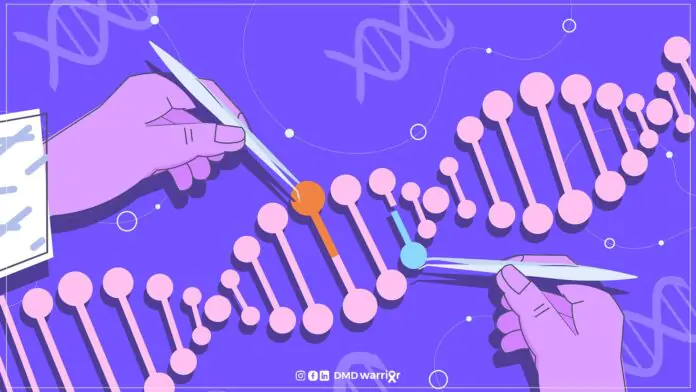A microdistrofina e a distrofina de comprimento total desempenham papéis cruciais no tratamento da distrofia muscular de Duchenne (DMD), uma doença genética que causa fraqueza muscular progressiva. Embora a distrofina de comprimento total seja a proteína ausente em indivíduos com DMD, a terapia com microdistrofina surge como uma alternativa promissora, oferecendo potenciais benefícios para aqueles com a doença.
Com 79 éxons — as seções de DNA que fornecem à célula as instruções para produzir uma proteína — o gene da distrofina é o maior gene do corpo. Atualmente, não é possível transferir o gene completo da distrofina para uma célula devido ao tamanho do gene e ao pequeno tamanho dos vetores usados para transferir os transgenes para as células. Para criar uma proteína funcionalmente mais curta, pesquisadores criaram microtransgenes de distrofina que preservam informações genéticas essenciais. – Leia mais: O Gene da Distrofina: Função, Distúrbios e Avanços Terapêuticos
Índice
Mecanismo da Micro Distrofina
A mutação do gene da distrofina, que causa a distrofia muscular de Duchenne, resulta em pouca ou nenhuma síntese funcional da proteína distrofina. Disponibilizar uma cópia funcional do gene da distrofina às células musculares para que elas possam começar a produzir a proteína distrofina é um possível tratamento para a distrofina. Este é o conceito subjacente ao uso de um produto de terapia genética para substituir células.
É possível iniciar a produção da proteína ausente introduzindo um transgene, que são instruções de DNA para o corpo fabricar uma proteína. Pessoas com DMD que apresentam uma ampla variedade de variantes genéticas devem ter a opção de terapia genética com microdistrofina, pois ela substitui o gene em vez de corrigir um defeito genético.
Transgenes de micro distrofina
O fato de o vetor, ou transportador, necessário para entregar o transgene às células ser pequeno demais para encapsular o gene completo da distrofina, necessário para produzir uma proteína distrofina de comprimento total, representa um obstáculo significativo para as técnicas de substituição genética existentes. Como resultado, os pesquisadores desenvolveram o que conhecemos como microtransgenes de distrofina. Esses microtransgenes de distrofina instruem as células a produzir uma forma truncada, porém funcional, da proteína.
Micro distrofina na distrofia muscular de Becker
As proteínas distrofinas funcionais, porém truncadas, observadas em certos pacientes com distrofia muscular de Becker serviram de inspiração para a invenção dessas microdistrofinas. É difícil comparar pessoas com Duchenne que recebem substituição genética com uma microdistrofina com aquelas com Becker, embora essas microdistrofinas sejam semelhantes às proteínas produzidas em alguns indivíduos com Becker. Isso ocorre porque esses indivíduos produzem essas proteínas em todas as suas células musculares desde o nascimento. Pessoas com Becker dificilmente se beneficiarão ou serão adequadas para terapia gênica com microdistrofina, pois normalmente produzem uma pequena distrofina semifuncional por conta própria. – Leia mais: Quais são as diferenças entre DMD e BMD?
Desafios da Micro Distrofina
O encurtamento da proteína traz novas dificuldades. Por exemplo, essas microdistrofinas exigem a exclusão de numerosos éxons que são componentes do gene da distrofina. Uma das muitas funções vitais da proteína distrofina no corpo é estabilizar a membrana das células musculares. As interações entre a proteína distrofina e diversas outras proteínas benéficas na membrana da célula muscular estabilizam a membrana.
Certas seções do gene da distrofina que interagem com outras proteínas eventualmente estarão ausentes de um transgene de microdistrofina, apesar dos esforços dos pesquisadores para serem criteriosos sobre quais partes são incluídas. Ter uma proteína microdistrofina, portanto, não será tão benéfico quanto ter a proteína distrofina completa, mas provavelmente ainda será melhor do que não ter distrofina disponível.
Respostas desconhecidas sobre a micro distrofina
Por quanto tempo as células musculares continuarão a gerar a microdistrofina, ou a resistência do transgênico, é outra incógnita na substituição do gene da microdistrofina. O DNA de um indivíduo não incorpora o transgene.
Pesquisas em animais foram feitas, mas para determinar por quanto tempo o transgene permanece nas células, precisamos avaliar sua resistência ao longo do tempo em humanos.
Existem vários fatores que podem afetar a durabilidade. A diluição, por exemplo, pode resultar na perda do transgene. À medida que uma pessoa envelhece, seu corpo ganha mais músculos do que quando jovem. O transgene ou a proteína microdistrofina podem não estar presentes nas células musculares recém-formadas, o que pode fazer com que se comportem como músculos distróficos normais.
Lesões musculares podem ser outra limitação à durabilidade. Células portadoras do transgene da microdistrofina podem ser perdidas como resultado de atividades físicas que utilizam ou danificam os músculos. Compreender a durabilidade e determinar se e quando a redosagem será necessária dependerá do monitoramento dos pacientes submetidos à substituição do gene da microdistrofina.
O Problema de Alcançar Todas as Células
Também é crucial lembrar que a microdistrofina seria produzida apenas por células musculares vivas portadoras do transgene. Isso implica que o transgene de microdistrofina não beneficiará nenhum tecido muscular que tenha sido substituído por fibrose ou gordura. As pessoas descobrirão se existe um momento ideal para administrar essa técnica específica de substituição genética à medida que mais pacientes em diferentes estágios da doença forem expostos à terapia genética com microdistrofina.
Relação entre Micro Distrofina e CK, AST e ALT
A terapia genética com microdistrofina reduz CK, AST e ALT para níveis normais? Os resultados do estudo randomizado de fase 3 do EMBARK com delandistrogene moxeparvovec (Elevidys) revelaram que a CK, a ALT e a AST não diminuíram para níveis normais aceitáveis. – Leia mais: Ensaio clínico randomizado de fase 3 EMBARK



